

How and Why Transtheoretic Transdiagnostic Psychotherapy Works. Two blogs ago I explain why cognitive behavior therapy works.
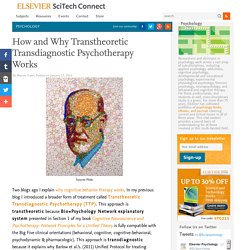
In my previous blog I introduced a broader form of treatment called Transtheoretic Transdiagnostic Psychotherapy (TTP). This approach is transtheoretic because Bio«Psychology Network explanatory system presented in Section 1 of my book Cognitive Neuroscience and Psychotherapy: Network Principles for a Unified Theory is fully compatible with the Big Five clinical orientations (behavioral, cognitive, cognitive-behavioral, psychodynamic & pharmacologic). This approach is transdiagnostic because it explains why Barlow et al.’s. (2011) Unified Protocol for treating emotional disorders and other empirically supported treatments work.
I explain more below. Here I explain how and why TTP works. The mind-bending effects of feeling two hearts. Our top 12 stories of 2014. #9: When a man was fitted with a new heart, his mind changed in unusual ways.

Why? The answer reveals a surprising truth about all our bodies, says David Robson. Every second or so, Carlos would feel a small “bump” hitting his tummy. It was the beating of his “second heart”. The small mechanical pump was meant to relieve the burden of his failing cardiac muscles, but Carlos (not his real name) disliked the sensation. Happy Birthday, Oliver Sacks: The Visionary Neurologist on What Hallucinations Reveal about How the Mind Works. By Maria Popova “We see with the eyes, but we see with the brain as well.”

While our delusions may keep us sane, hallucinations — defined as perceptions that arise independently of external reality, as when we see, hear, or sense things that aren’t really there — are an entirely different beast, a cognitive phenomenon that mimics mysticism and has no doubt inspired mystical tales over the millennia. In the 18th century, Swiss lawyer-turned-naturalist Charles Bonnet, the first scientist to use the term evolution in a biological context, turned to philosophy after deteriorating vision rendered him unable to perform the necessary observations of science. Emotional Memory - explaining a child's and a parent's raw reactions. A few months ago, one of our last days in UK, the four of us rocked up to a park, eager to get some air after being stuck in a bit of gnarly traffic.
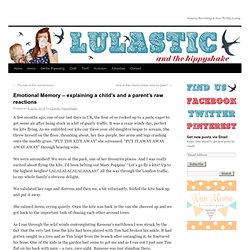
It was a crazy windy day, perfect for kite flying. As we unfolded our kite our three year old daughter began to scream. She threw herself on the floor, thrashing about, her face purple, her arms and legs crashing onto the muddy grass. “PUT THE KITE AWAY” she screamed. Neurocomic: A Graphic Novel About How the Brain Works. By Maria Popova From the caves of memory to the castles of deception, by way of naughty neurotransmitters and giddy ganglia.
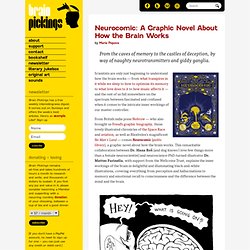
Scientists are only just beginning to understand how the brain works — from what transpires in it while we sleep to how to optimize its memory to what love does to it to how music affects it — and the rest of us fall somewhere on the spectrum between fascinated and confused when it comes to the intricate inner workings of our master-controller. From British indie press Nobrow — who also brought us Freud’s graphic biography, those lovely illustrated chronicles of the Space Race and aviation, as well as Blexbolex’s magnificent No Man’s Land — comes Neurocomic (public library), a graphic novel about how the brain works. This remarkable collaboration between Dr. Hana Roš (and dog knows I love few things more than a female neuroscientist) and neuroscience-PhD-turned-illustrator Dr.
Suzana Herculano-Houzel: What is so special about the human brain? Exploring the inner workings of the healthy brain. Scientists working under the aegis of the Max Planck Society are in an enviable position.

With a budget of more than €1.5 billion to fund more than 80 institutes, the Society gives its researchers freedom to explore the basic science area of their choice without the expectation of a "micro-economic return on investment," said Dr. Peter Gruss, president of the Munich, Germany-based research organization. "No one tells us what research we should do.
We have no programs. We hire the best people, and they are free to do autonomous, creative work in structural units we call Max Planck Institutes. " How does my brain work? Connectome: A New Way To Think About What Makes You You. By Maria Popova “You are more than your genes.

You are your connectome.” The nature vs. nurture debate pitted the hard and social sciences against each other for decades, if not centuries, stirred by a central concern with consciousness, what it means to be human, what makes a person, and, perhaps most interestingly to us egocentric beings, what constitutes character and personality. In Connectome: How the Brain’s Wiring Makes Us Who We Are, MIT Professor of Computational Neuroscience Sebastian Seung proposes a new model for understanding the totality of selfhood, one based the emerging science of connectomics — a kind of neuroscience of the future that seeks to map and understand the brain much like genomics has mapped the genome.
Some people do feel more than others, and it’s all in their genes. Some people do feel more than others, and it’s all in their genes Gabriella Munoz Wednesday, 25 June 2014 A new study has found that some people have a greater emotional sensitivity and are programmed to better recognise and understand what others are going through.
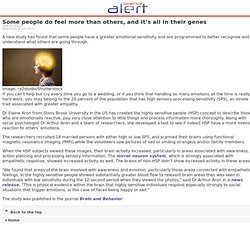
Image: ra2studio/Shutterstock. Six basic human emotions: What if we really only have four? How to Optimize Your Brain: Why Refining Emotional Recall is the Secret to Better Memory. By Maria Popova “You are what you remember — your very identity depends on all of the events, people and places you can recall.”
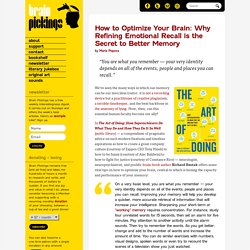
We’ve seen the many ways in which our memory can be our merciless traitor: it is not a recording device but a practitioner of creative plagiarism, a terrible timekeeper, and the bent backbone in the anatomy of lying. How, then, can this essential human faculty become our ally? The Science of How Memory Works. Peter Doolittle: How your "working memory" makes sense of the world. Close Help with subtitles Desktop / laptop users: please make sure you have the most updated versions of your browser and Flash player, and that Flash is enabled when you visit TED.com. iOS users: to access subtitles, start playing the video, then tap the speech bubble icon that appears in the bottom row of video controls.

Android users: although Android devices do not support subtitles, you can download the TED app from the Google Play store. The Science of Smell: How the Most Direct of Our Senses Works. The Master and His Emissary. The Master and His Emissary: The Divided Brain and the Making of the Western World is a 2009 book written by Iain McGilchrist that deals with the specialist hemispheric functioning of the brain. The Evolutionary Mystery of Left-Handedness and What It Reveals About How the Brain Works.
By Maria Popova From Medieval sword-fighters to Broca’s brains, or why the hand may hold the key to the link between creativity and mental illness. “Sahara is too little price / to pay for thy Right hand,” Emily Dickinson wrote in a poem. “The right hand = the hand that is aggressive, the hand that masturbates,” Susan Sontag pondered in her diary in 1964.